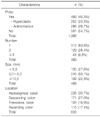Abstract
Controversy remains over the role of risk factors in developing colorectal polyps. The aim of this study was to investigate the relationship of colorectal polyps with risk factors including obesity, age, alcohol, and smoking. We retrospectively assessed colorectal polyps through medical records and patient interviews of 1080 patients who underwent colonoscopy regardless of symptoms. The degree of obesity was determined by body mass index (BMI), and colorectal polyps were divided into hyperplastic and adenomatous polyps. The prevalence of colorectal polyps was 45.3% (489 patients). Of these, the prevalences of hyperplastic polyps and adenomatous polyps were 23.3% and 26.7%, respectively. The most common number, size, and location of colorectal polyps were one (63.8%), 5.0~9.0 mm (50.1%), and rectosigmoid colon (35.7%), respectively. Age, amount of alcohol, and smoking were significantly higher in the group with polyps than in that without polyps (54.9±11.3 vs. 50.0±13.1 years, 75.8 vs. 39.3 g/week, and 9.3±12.6 vs. 4.6±9.1 pack years, respectively, p=0.001). There were no significant differences in BMI between the groups with (23.2 kg/m2) or without (23.1 kg/m2) polyps. Also, there was no significant relationship between BMI and the size, number, or location of colorectal polyps. Age, alcohol, and smoking were associated with colorectal polyps by one-way ANOVA test but not by multivariate logistic regression analysis. Additionally, BMI had no relationship with the size, number, or location of colorectal polyps. In conclusion, age, alcohol drinking, and smoking may be associated with colorectal polyps, but obesity as assessed by BMI was not.
Figures and Tables
References
1. Ministry of Health and Welfare. Korea Central Cancer Registry. Annual Report of the Korea Central Cancer Registry. 2002.
2. Korea National Statistical Office. Annual Report on the Cause of Death Statistics. 2006.
3. Jackman RJ, Mayo CW. The adenoma-carcinoma sequence in cancer of the colon. Surg Gynecol Obstet. 1951. 93:327–330.
4. Kearney J, Giovannucci E, Rimm EB, Stampfer MJ, Colditz GA, Ascherio A, et al. Diet, alcohol, and smoking and the occurrence of hyperplastic polyps of the colon and rectum (United States). Cancer Causes Control. 1995. 6:45–56.

5. Morimoto LM, Newcomb PA, Ulrich CM, Bostick RM, Lais CJ, Potter JD. Risk factors for hyperplastic and adenomatous polyps: evidence for malignant potential? Cancer Epidemiol Biomarkers Prev. 2002. 11:1012–1018.
6. Oh K, Redston M, Odze RD. Support for hMLH1 and MGMT silencing as a mechanism of tumorigenesis in the hyperplastic-adenomacarcinoma (serrated) carcinogenic pathway in the colon. Hum Pathol. 2005. 36:101–111.

7. Ministry of Health and Welfare. The Third Korean National Health and Nutrition Examination Survey. 2006.
8. Neugut AI, Lee WC, Garbowski GC, Waye JD, Forde KA, Treat MR, et al. Obesity and colorectal adenomatous polyps. J Natl Cancer Inst. 1991. 83:359–361.

9. Murphy TK, Calle EE, Rodriguez C, Kahn HS, Thun MJ. Body mass index and colon cancer mortality in a large prospective study. Am J Epidemiol. 2000. 152:847–854.

10. Russo A, Franceschi S, La Vecchia C, Dal Maso L, Montella M, Conti E, et al. Body size and colorectal-cancer risk. Int J Cancer. 1998. 78:161–165.

11. Shinchi K, Kono S, Honjo S, Todoroki I, Sakurai Y, Imanishi K, et al. Obesity and adenomatous polyps of the sigmoid colon. Jpn J Cancer Res. 1994. 85:479–484.

12. Lee WC, Neugut AI, Garbowski GC, Forde KA, Treat MR, Waye JD, et al. Fenoglio-Preiser C. Cigarettes, alcohol, coffee, and caffeine as risk factors for colorectal adenomatous polyps. Ann Epidemiol. 1993. 3:239–244.

13. Todoroki I, Kono S, Shinchi K, Honjo S, Sakurai Y, Wakabayashi K, et al. Relationship of cigarette smoking, alcohol use, and dietary habits with sigmoid colon adenomas. Ann Epidemiol. 1995. 5:478–483.

14. Longnecker MP, Chen MJ, Probst-Hensch NM, Harper JM, Lee ER, Frankl HD, et al. Alcohol and smoking in relation to the prevalence of adenomatous colorectal polyps detected at sigmoidoscopy. Epidemiology. 1996. 7:275–280.

15. Bae TS, Jung KH, Lee JH, Oh MG, Chung BO, Bae SH, et al. Clinical significance of the colorectal polyps. J Korean Soc Coloproctol. 2000. 24:247–253.
16. Yano T, Sano Y, Iwasaki J, Fu KI, Yoshino T, Kato S, et al. Distribution and prevalence of colorectal hyperplastic polyps using magnifying pan-mucosal chromoendoscopy and its relationship with synchronous colorectal cancer: prospective study. J Gastroenterol Hepatol. 2005. 20:1572–1577.

17. Giovannucci E, Stampfer MJ, Colditz GA, Rimm EB, Trichopoulos D, Rosner BA, et al. Folate, methionine, and alcohol intake and risk of colorectal adenoma. J Natl Cancer Inst. 1993. 85:875–884.

18. Ji JH, Park BJ, Park YS, Hwang JH, Chung SH, Kim N, et al. Clinicopathologic study of colorectal polyps and obesity in Korean adults. Korean J Gastroenterology. 2007. 49:10–16.
19. Ruth M, Månsson I, Sandberg N. The prevalence of symptoms suggestive of esophageal disorders. Scand J Gastroenterol. 1991. 26:73–81.

20. Fraser-Moodie CA, Norton B, Gornall C, Magnago S, Weale AR, Holmes GK. Weight loss has an independent beneficial effect on symptoms of gastro-oesophageal reflux in patients who are overweight. Scand J Gastroenterol. 1999. 34:337–340.

21. Shiffman ML, Kaplan GD, Brinkman-Kaplan V, Vickers FF. Prophylaxis against gallstone formation with ursodeoxycholic acid in patients participating in a very-low-calorie diet program. Ann Intern Med. 1995. 122:899–905.

22. Festi D, Colecchia A, Orsini M, Sangermano A, Sottili S, Simoni P, et al. Gallbladder motility and gallstone formation in obese patients following very low calorie diets. Use it (fat) to lose it (well). Int J Obes Relat Metab Disord. 1998. 6:592–600.

24. Schoen RE, Weissfeld JL, Kuller LH, Thaete FL, Evans RW, Hayes RB, et al. Insulin-like growth factor-1 and insulin are associated with the presence and advancement of adenomatous polyps. Gastroenterology. 2005. 129:464–475.





 PDF
PDF ePub
ePub Citation
Citation Print
Print








 XML Download
XML Download